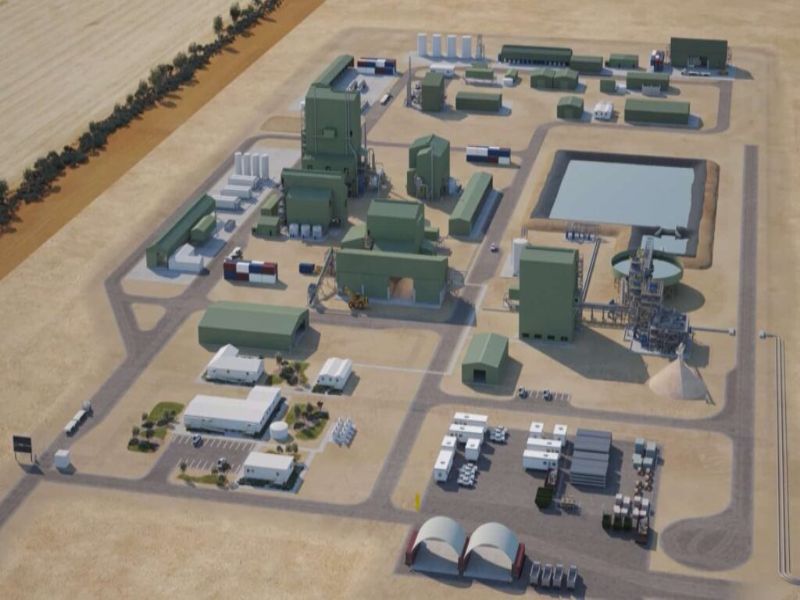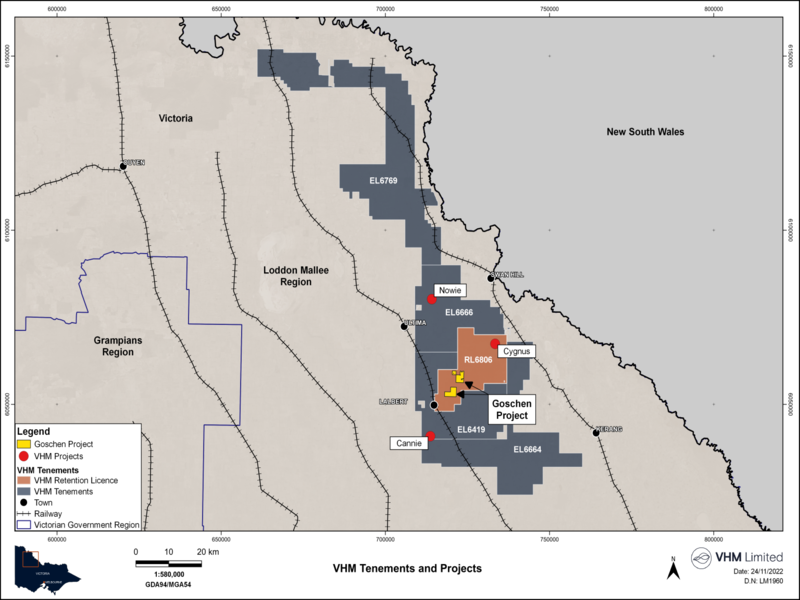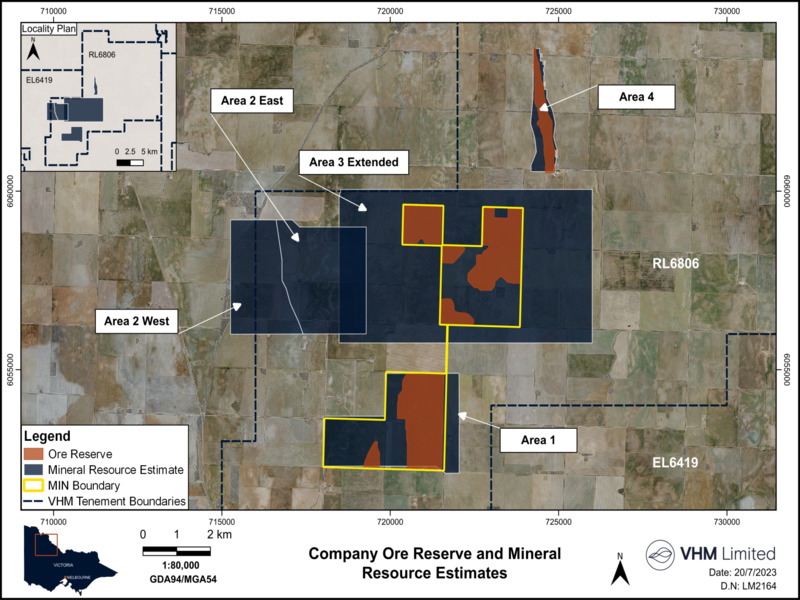The Goschen Mineral Sands and Rare Earths project is the flagship project of Australia-based company VHM. The project, which contains rare earth deposit of 413,107 tonnes of total rare earth oxide (TREO), is located in North-West Victoria, Australia.
Goschen received Major Project status from the federal government in 2021.
A pre-feasibility study (PFS) report of Goschen project was announced in December 2021. It was followed by the completion of the Definitive Feasibility Study (DFS) in March 2022.
VHM announced the results of the DFS Refresh in March 2023, an update on the DFS, to confirm the potentiality of the project.
Project Gallery
According to the DFS Refresh, Goschen would be a high-value, low-cost operation and produce zircon-titania Heavy Mineral Concentrate (HMC), Rare Earth Mineral Concentrate (REMC), and a Mixed Rare Earth Carbonate (MREC).
The project would have a nameplate process feed rate of 5 million tonnes per annum (Mtpa) for a foundation 20 year mine life.
It would be developed over multiple phases, with first production expected in 2025 (subject to the approvals timeline).
Around 70% of Goschen’s revenue will be generated via rare earth products such as neodymium, praseodymium, dysprosium, and terbium. These products are critical for industries such as electric vehicles, energy efficiency and technology.
Goschen Project Location
The Goschen Project is located in the Loddon Mallee Region of Victoria, around 35km southwest of Swan Hill in the Gannawarra Shire and 275km north of Melbourne.
The project is situated within Retention Lease (RL) 6806 and Exploration Licence (EL) 6419, which are held by VHM.
Mining and processing will be carried out in Area 1 and Area 3, which jointly cover around 1,534 hectares (ha).
Geology and Mineralisation
Goschen project’s heavy mineral sands are located as a fine-grained deposit within the offshore depositional paleo-environment of the Loxton Parilla Sands.
According to the DFS Refresh, alluvial sediments of the Shepparton Formation deposited over the Loxton-Parilla Sand.
Containing shallow marine clays and marls, the Bookpurnong Formation is located beneath within the lithological sequence.
There are two distinct styles of deposits- sheets and strandlines.
The sheet-style deposits, also known as Wimmera-style (WIM-style) deposits, contain relatively fine-grained heavy mineral (sub-100 micrometre (µm) with some in the 20–40µm range).
The strandline-type deposits are formed in high-energy surf zone and may attain strike lengths of 5–40km. They can contain some coarse-grained heavy minerals.
Goschen Mineral Resource Estimate
The Goschen project is estimated to contain 413,107 tonnes of total rare earth oxide (TREO).
Mineral Resource estimates and the Ore Reserve estimates are mostly based on RL 6806 with some minor incursions into surrounding VHM-held tenements.
Total ore reserves (Area 1 and Area 3) stand at 198.7 Million Tonnes (Mt). The initial operation will recover 98.8 Mt, representing around 50% of identified Ore Reserve.
The project’s total mineral resource estimate (measured, indicated, and inferred resources) of 629Mt includes areas that are excluded from current mining proposal.
Goschen Project Development
The proposed project development aims for a 20-year, 5Mtpa operation to mine and process zircon, titania, and rare earths mineral deposits.
It will be developed in three phases.
Phase 1 will include a Mining Unit Plant (MUP), Feed Preparation Plant (FPP), Wet Concentrator Plant (WCP) and a Rare Earth Mineral Flotation Circuit (REMFC) to produce Rare Earth Mineral Concentrate (REMC) and zircon-titania concentrate.
Phase 1A will introduce a hydromet circuit to further upgrade the REMC into a higher-value MREC.
Phase 2 will add another MSP to produce final mineral sand products such as ilmenite, zircon, leucoxene, and HiTi/rutile.
The project will proceed to Phase 2 if certain conditions are met including prevailing market conditions and availability of funding. However, it is not subject to the Final Investment Decision (FID) for Phase 1 and 1A.
Goschen is projected to create at least 200 construction jobs and 400 new full-time jobs.
The first phase will entail an investment of around A$376m ($245.3m) excluding ancillary cost, while Phase 1A Hydromet Circuit will cost an additional A$124m ($81m).
Based on a 20-year mine life, the project will have a pre-tax Net Present Value (NPV) of A$1.5bn ($980m). It is expected to generate a pre-tax cash flow of A$270m ($176m) per year.
VHM submitted the mining licence application to the Earth Resources Regulator (ERR) in March 2023. The application was placed on public notice in January 2024.
ERR’s review and issuance of the mining licence is contingent on the outcome of the Environment Effects Statement (EES) approvals process.
Mining Method
The rare earth project will be mined via conventional open-pit mining methods using excavator, load, and truck haulage.
Mining activity at Goschen will commence in Area 1, and then progress to Area 3. All mining will be conducted above the water table, thus ruling out the need to extract groundwater.
A strip/block mining operation will be undertaken involving excavation, tailings deposition and rehabilitation.
The mining sequence is designed to support complete extraction of ore, construction of in-pit tailings cells and deposing tailings into tailings cells.
Each of the mining blocks will be around 200m along-strike and of different widths to suit prevailing ground conditions.
The recovered ore will be loaded onto trucks and then transported to the MUP for processing.
Bulldozers and front-end loaders will also be used to support mining operations.
Processing
The ore recovery, the run of mine (RoM) will be stockpiled before sending it to the MUP via a front-end loader. It will pass through a grizzly to remove oversized pieces.
Sand and clay agglomerates will be broken down in a scrubber and the slurry will be transported to the FPP at the main processing plant.
At FPP, the sand containing the heavy minerals will be separated from clay fraction (slimes) and the deslimed, and then the screened sand will be sent to the WCP. Barren sand will be separated from the heavy minerals using spirals at WCP.
Subsequently, the heavy minerals will be directed to the REMFC. The rejected sand will be combined with the slimes and disposed back to the pit.
Coarse silicates and iron oxides will be removed from heavy minerals to improve the concentrate grade to around 92%.
A REMC (consisting mostly of the minerals xenotime and monazite) will be recovered from the HMC via flotation and gravity separation. In Phase 2, the remaining residue post flotation (P-flotation) concentrate will be directed to the wet MSP or dewatered and stockpiled as a final product.
The hydromet circuit, after commissioning in Phase 1A, will process REMC.
The final product will be loaded into bulk bags for shipping. It will be transported via road to the Ultima intermodal terminal and then by rail to the Port of Melbourne for shipment.
Infrastructure
The process plant is planned to be located on the western side of Area 1.
As mentioned, the project will include the FPP, WCP, REMFC, MSP, Hydromet Circuit, reagent storage, tailings thickener, process water dam, ancillary buildings, as well as Heavy Mineral Concentrate (HMC) and P-flotation stockpiles.
Power required for project operations will be provided by a third-party contractor using nominally 12 x 11kV high-voltage dual-fuel generators. Goschen project is expected to switch to renewable power when it becomes available.
The project is estimated to require up to 4.5 Gigalitres Per Annum (Gl/a) of water for the initial 12 months and then 3.2Gl/a later.
Water will be delivered to the Goschen site via a new 38km underground pipeline to be constructed beneath existing local road easements.
Goschen Offtake Agreement
In February 2024, VHM signed a binding offtake agreement with Shenghe Resources (Singapore), a wholly owned subsidiary of global rare earths company, Shenghe Resources Holding, regarding its Goschen Rare Earth and Mineral Sands project Phase 1 products.
The agreement will involve supplying 6,400 tonnes per annum of REMC and 100,000 tonnes of zircon/ titania HMC products for an initial three-year term.
Contractors Involved
Several independent consultants were involved with the preparation of the Goschen project DFS.
Auralia Mining Consultants carried out a mining study on the area for which VHM submitted a mining application to the Victorian government. The study was included in the March 2022 DFS.
Mineral Technologies assisted VHM with the engineering and development of the mineral processing aspects of the rare earths project.
AECOM was associated with environmental and community, power and water supply, closure, and rehabilitation, while CSA Global provided Independent technical assessment report (ITAR).
Some other firms associated include Adamas Intelligence, ANSTO, ATC Williams, BDO Australia, CDM Smith, GPA Engineering, JRHC Enterprises, pitt&sherry, Qube Holdings, and Right Solutions Australia among others.



